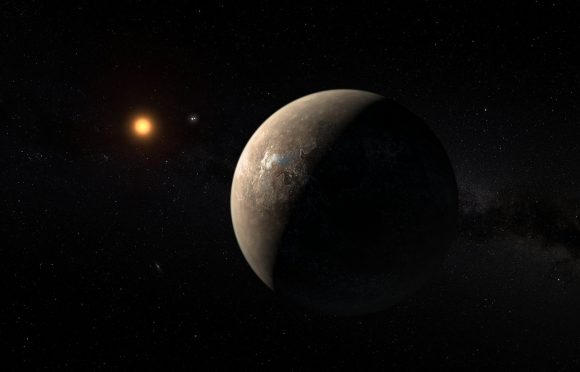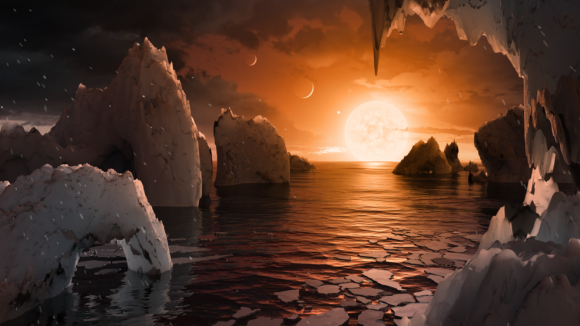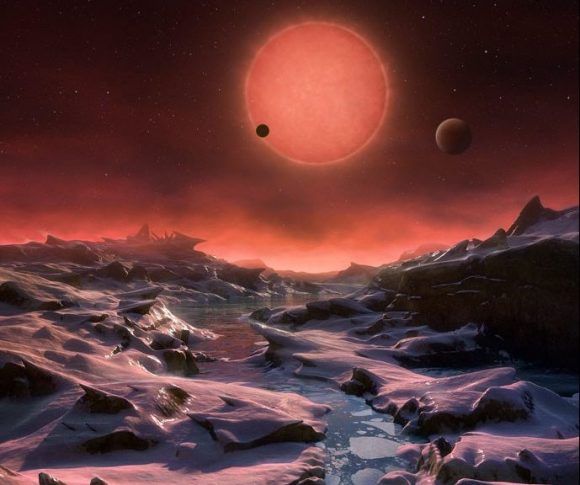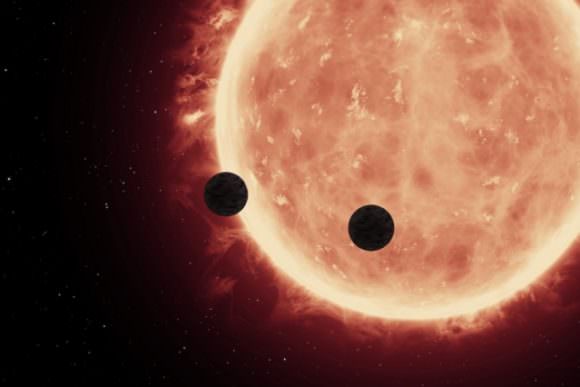When hunting for potentially habitable exoplanets, one of the most important things astronomers look for is whether or not exoplanet candidates orbit within their star's habitable zone. This is necessary for liquid water to exist on a planet's surface, which in turn is a prerequisite for life as we know it. However, in the course of discovering new exoplanets, scientists have become aware of an extreme case known as "water worlds".
Water worlds are essentially planets that are up to 50% water in mass, resulting in surface oceans that could be hundreds of kilometers deep. According to a new study by a team of astrophysicists from Harvard, Princeton and the University of Michigan, water worlds may not be able to hang on to their water for very long. These findings could be of immense significance when it comes to the hunt for habitable planets in our neck of the cosmos.
This most recent study, titled "The Dehydration of Water Worlds via Atmospheric Losses", recently appeared in The Astrophysical Journal Letters. Led by Chuanfei Dong from the Department of Astrophysical Sciences at Princeton University, the team conducted computer simulations that took into account what kind of conditions water worlds would be subject to.

Artist's impression of the planet orbiting a red dwarf star. Credit: ESO/M. Kornmesser
This study was motivated largely by the number of exoplanet discoveries have been made around low-mass, M-type (red dwarf) star systems in recent years. These planets have been found to be comparable in size to Earth - which indicated that they were likely terrestrial (i.e. rocky). In addition, many of these planets - such as Proxima b and three planets within the TRAPPIST-1 system - were found to be orbiting within the stars habitable zones.
However, subsequent studies indicated that Proxima b and other rocky planets orbiting red dwarf stars could in fact be water worlds. This was based on mass estimates obtained by astronomical surveys, and the built-in assumptions that such planets were rocky in nature and did not have massive atmospheres. At the same time, numerous studies have been produced that have cast doubt on whether or not these planets would be able to hold onto their water.
Basically, it all comes down to the type of star and the orbital parameters of the planets. While long-lived, red dwarf stars are known for being variable and unstable compared to our Sun, which results in periodic flares up that would strip a planet's atmosphere over time. On top of that, planets orbiting within a red dwarf's habitable zone would likely be tidally-locked, meaning one side of the planet would be constantly exposed to the star's radiation.
Because of this, scientists are focused on determining just how well exoplanets in different types of star systems could hold onto their atmospheres. As Dr. Dong told Universe Today via email:
"It is fair to say that the presence of an atmosphere is perceived as one of the requirements for the habitability of a planet. Having said that, the concept of habitability is a complex one with myriad factors involved. Thus, an atmosphere by itself will not suffice to guarantee habitability, but it can be regarded as an important ingredient for a planet to be habitable."

Illustration showing the possible surface of TRAPPIST-1f, one of the newly discovered planets in the TRAPPIST-1 system. Credits: NASA/JPL-Caltech
To test whether or not a water world would be able to hold onto its atmosphere, the team conducted computer simulations that took into account a variety of possible scenarios. These included the effects of stellar magnetic fields, coronal mass ejections, and atmospheric ionization and ejection for various types of stars - including G-type stars (like our Sun) and M-type stars (like Proxima Centauri and TRAPPIST-1).
With these effects accounted for, Dr. Dong and his colleagues derived a comprehensive model that simulated how long exoplanet atmospheres would last. As he explained it:
"We developed a new multi-fluid magnetohydrodynamic model. The model simulated both the ionosphere and magnetosphere as a whole. Due to the existence of the dipole magnetic field, the stellar wind cannot sweep away the atmosphere directly (like Mars due to the absence of a global dipole magnetic field), instead, the atmospheric ion loss was caused by the polar wind.
"The electrons are less massive than their parent ions, and as a result, are more easily accelerated up to and beyond the escape velocity of the planet. This charge separation between the escaping, low-mass electrons and significantly heavier, positively-charged ions sets up a polarization electric field. That electric field, in turn, acts to pull the positively charged ions along behind the escaping electrons, out of the atmosphere in the polar caps."

Artist's impression of the view from the most distant exoplanet discovered around the red dwarf star TRAPPIST-1. Credit: ESO/M. Kornmesser.
What they found was that their computer simulations were consistent with the current Earth-Sun system. However, in some extreme possibilities - such as exoplanets around M-type stars - the situation is very different and the escape rates could be one thousand times greater or more. The result means that even a water world, if it orbits an red dwarf star, could lose its atmosphere after about a gigayear (Gyr), one billion years.
Considering that life as we know it took around 4.5 billion years to evolve, one billion years is a relatively brief window. In fact, as Dr. Dong explained, these results indicate that planets that orbit M-type stars would be hard pressed to develop life:
"Our results indicate that the ocean planets (orbiting a Sun-like star) will retain their atmospheres much longer than the Gyr timescale as the ion escape rates are far too low, therefore, it allows a longer duration for life to originate on these planets and evolve in terms of complexity. In contrast, for exoplanets orbiting M-dwarfs, they could have their oceans depleted over the Gyr timescale due to the more intense particle and radiation environments that exoplanets experience in close-in habitable zones. If the atmosphere were to be depleted over the timescale less than Gyr, this could prove to be problematic for the origin of life (abiogenesis) on the planet."
Once again, these results cast doubt on the potential habitability of red dwarf star systems. In the past, researchers have indicated that the longevity of red dwarf stars, which can remain in their main sequence for up to 10 trillion years or longer, make them the best candidate for finding habitable exoplanets. However, the stability of these stars and the way in which they are likely to strip planets of their atmospheres seems to indicate otherwise.

An artist's depiction of planets transiting a red dwarf star in the TRAPPIST-1 System. Credit: NASA/ESA/STScl
Studies such as this one are therefore highly significant in that they help to address just how long a potentially habitable planet around a red dwarf star could remain potentially habitable. As Dr. Dong indicated:
"Given the importance of atmospheric loss on planetary habitability, there has been a great deal of interest in using telescopes such as the upcoming James Webb Space Telescope (JWST) to determine whether these planets have atmospheres and, if so, what their composition are like. It is expected that the JWST should be capable of characterizing these atmospheres (if present), but quantifying the escape rates accurately requires a much higher degree of precision and may not be feasible in the near-future."
The study is also significant as far as our understanding of the Solar System and its evolution is concerned. At one time, scientists have ventured that both Earth and Venus may have been water worlds. How they made the transition from being very watery to what they are today - in the case of Venus, dry and hellish; and in the case of Earth, having multiple continents - is an all-important question.
In the future, more detailed surveys are anticipated that could help shed light on these competing theories. When the James Webb Space Telescope (JWST) is deployed in Spring of 2018, it will use its powerful infrared capabilities to study planets around nearby red dwarfs, Proxima b being one of them. What we learn about this and other distant exoplanets will go a long way towards informing our understanding of how own Solar System evolved as well.
Further Reading: CfA, The Astrophysical Journal Letters
No comments:
Post a Comment